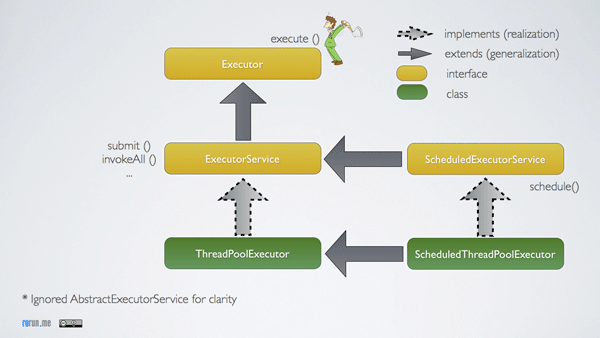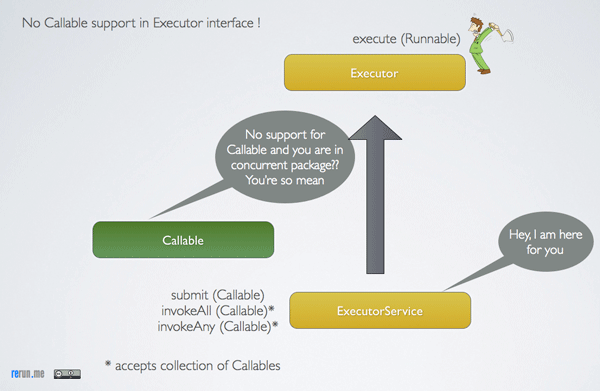I would make a fool out of myself if I tell you that util.concurrent APIs kicks cheetah's ass when the classes are available since 2004. However, there are some cool features which I would like to revisit. Concurrency experts, now is the time for you to close this window. All others, stay tight for the fun ride.
Thou shall not forget your roots

Executor is the root interface with a single execute method. Anything that implements a Runnable interface can passed as a parameter. Silly Executor, however, has no support for Callable though.

Good news : ExecutorService interface, which extends Executor, adds support for Callable. Its implementation class is ThreadPoolExecutor.
I am going to pretend that the ScheduledExecutorService interface and its implementation class ScheduledThreadPoolExecutor does not exist as they just add scheduling capabilities on top of the ExecutorService and ThreadPoolExecutor. But remember this class when the powerful but boring java.util.Timer is not enough and a full blown external scheduler is just too much.
If you are new to concurrency or forgot the difference between Callable and Runnable, you might want to read up a little before reading further. A dummy guide is here
The ExecutorService.submit Facts :
The three submit variants :
Future submit(Callable task) <br>
Future submit(Runnable task) <br>
Future submit(Runnable task, T result)
-
The
submitmethod of the ExecutorService is overloaded and accepts either aCallableorRunnable. -
Since the
runmethod of the Runnable returns void, it is no surprise thatFuture.getalways returns a null when the task is complete.
Future<?> submit(Runnable task)
- The other overloaded
submitmethod that accepts aRunnableand a generic returns whatever you passed in as the second parameter as the result.
<T> Future<T> submit(Runnable task, T result)
In fact, opening up the code (FutureTask), you'll notice that the RunnableAdapter top level nested class of Executors simply holds the result and returns the same result after the run method is complete.
###为何用ThreadPoolExecutor 的submit(runnable,T result)却是可以返回结果的呢??
static final class RunnableAdapter<T> implements Callable<T> {
final Runnable task;
final T result;
RunnableAdapter(Runnable task, T result) {
this.task = task;
this.result = result;
}
public T [More ...] call() {
task.run();
return result;
}
}
In both the cases, if you would like to (you should !) terminate the program instead of your executor thread blocking the program and entering a busy loop, you should call the shutdown method as in
executorService.shutdown()
shutDown facts
You could imagine shutdown as a half-closed door of a mall. No new customers will be let in but the existing customers can leave the mall once they are done.
To reiterate,
-
shutdownis a polite method. It does not actually shut down the tasks in the pool immediately. It just says that no new tasks will be accepted. -
Unless you are executing your tasks using
invokeAll, you would need to wait for all tasks in progress to complete. This is achieved by calling theawaitTerminationmethod.
(invokeAll and submit examples at the bottom of the post) -
Once all the current tasks are done, the executor service shuts down.
If you are in need of an impolite, intruding method which doesn't care whether the current threads are done with their tasks, then shutdownNow is your guy. However, there's no guarantee that the method will shutdown the service on the dot but it is the closest you have to immediate shutdown.




 本文深入探讨了Java并发编程的核心概念,介绍了ExecutorService接口及其实现类ThreadPoolExecutor的功能与使用方法,并对比了Callable与Runnable的不同之处。此外,还详细解析了如何通过submit方法提交任务并获取结果。
本文深入探讨了Java并发编程的核心概念,介绍了ExecutorService接口及其实现类ThreadPoolExecutor的功能与使用方法,并对比了Callable与Runnable的不同之处。此外,还详细解析了如何通过submit方法提交任务并获取结果。

















 170万+
170万+

 被折叠的 条评论
为什么被折叠?
被折叠的 条评论
为什么被折叠?








